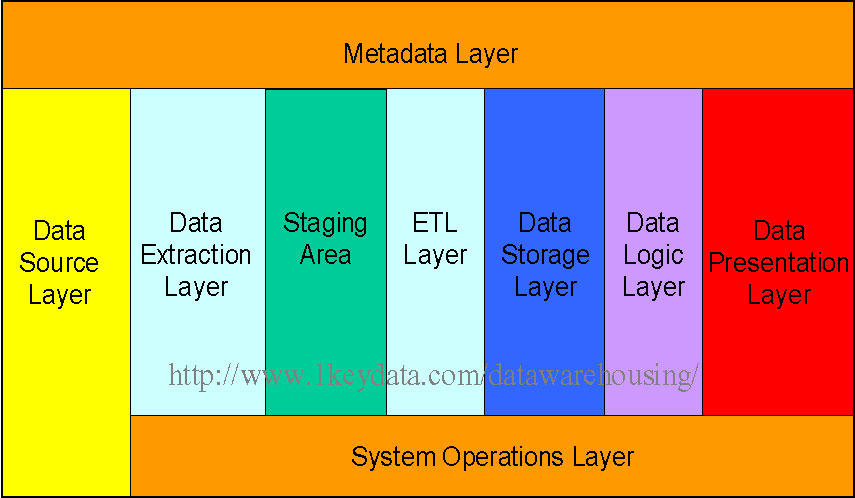AdBlock Detected!
Our website is made possible by displaying ads to our visitors. Please supporting us by whitelisting our website.
Data Warehouse Architecture |
Different data warehousing systems have different structures. Some may have an ODS (operational data store), while some may have multiple data marts. Some may have a small number of data sources, while some may have dozens of data sources. In view of this, it is far more reasonable to present the different layers of a data warehouse architecture rather than discussing the specifics of any one system.
In general, all data warehouse systems have the following layers:
The picture below shows the relationships among the different components of the data warehouse architecture:

Each component is discussed individually below:
Data Source Layer
This represents the different data sources that feed data into the data warehouse. The data source can be of any format -- plain text file, relational database, other types of database, Excel file, etc., can all act as a data source.
Many different types of data can be a data source:
All these data sources together form the Data Source Layer.
Data Extraction Layer
Data gets pulled from the data source into the data warehouse system. There is likely some minimal data cleansing, but there is unlikely any major data transformation.
Staging Area
This is where data sits prior to being scrubbed and transformed into a data warehouse / data mart. Having one common area makes it easier for subsequent data processing / integration.
ETL Layer
This is where data gains its "intelligence", as logic is applied to transform the data from a transactional nature to an analytical nature. This layer is also where data cleansing happens. The ETL design phase is often the most time-consuming phase in a data warehousing project, and an ETL tool is often used in this layer.
Data Storage Layer
This is where the transformed and cleansed data sit. Based on scope and functionality, 3 types of entities can be found here: data warehouse, data mart, and operational data store (ODS). In any given system, you may have just one of the three, two of the three, or all three types.
Data Logic Layer
This is where business rules are stored. Business rules stored here do not affect the underlying data transformation rules, but do affect what the report looks like.
Data Presentation Layer
This refers to the information that reaches the users. This can be in a form of a tabular / graphical report in a browser, an emailed report that gets automatically generated and sent everyday, or an alert that warns users of exceptions, among others. Usually an OLAP tool and/or a reporting tool is used in this layer.
Metadata Layer
This is where information about the data stored in the data warehouse system is stored. A logical data model would be an example of something that's in the metadata layer. A metadata tool is often used to manage metadata.
System Operations Layer
This layer includes information on how the data warehouse system operates, such as ETL job status, system performance, and user access history.
Our website is made possible by displaying ads to our visitors. Please supporting us by whitelisting our website.